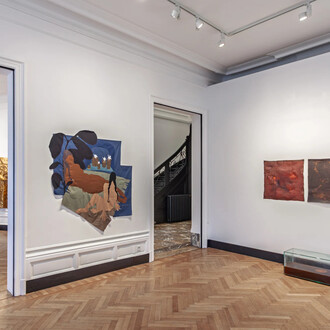In this large-scale work Aïda Kazarian (1952) tirelessly repeats the ngerprint of her index. She applies paint in a boustrophedon manner that is typical of the work of Caucasus rugs, re ecting the intermixing of cultures in that region. This refers directly to her Armenian family roots. She questions the support with this semi-transparent navy canvas which partly reveals the structure of the frame. The slightly pearlescent colour reacts delicately to the light and the variety of the traces generates a feel of soft vibration.
Adrien Lucca (1983) has been working for many years on light and colour. Here he is proposing an extension of the experiments presented last year in his personal show as well as those that led to making the permanent installation in the Rotterdam metro inaugurated in December 2018.
Yoann Van Parijs (1981) collects and assembles. He superimposes and apposes. He captures what strikes him in the urban space, both through photographs and through sketches. He gathers fragments from building sites, on which he applies his layers of paint which scramble or illuminate his vision of the world. And so he oscillates between abstraction and guration, between reality and energy.
Pep Vidal (1980) is presenting ‘Tree’: at the origin of this painting/sculpture there is the discovery, on a pavement in Amsterdam, of a small r tree. Then came the insane desire to go and plant it back in Sweden, in a kind of expedition to return to the origins. Then, as often with Pep Vidal, came the question of the volume of that tree. He was to use the method called ‘rolling painting’. The quantity of water you could put in the cylinder corresponds to the volume of the tree and the quantity of paint used would make it possible to cover the whole of it.
Lionel Estève (1967) invites us to contemplate some stones which seem to have gorged themselves in contact with a coloured brook. Some of them are equipped with dividing lines between air and water, while other ones are entirely submerged. The watercolour caresses the stone and addresses a notion that is dear to the artist: that of producing a painting which questions sculpture.














